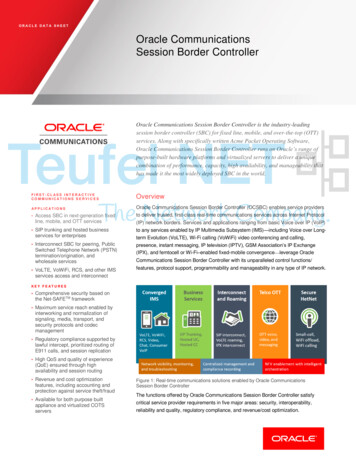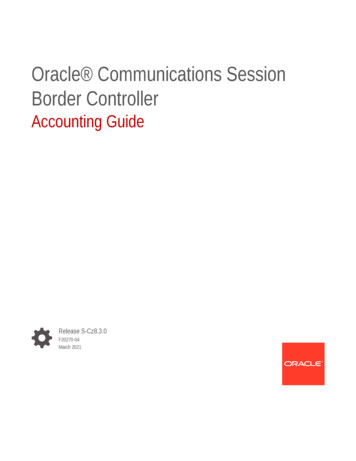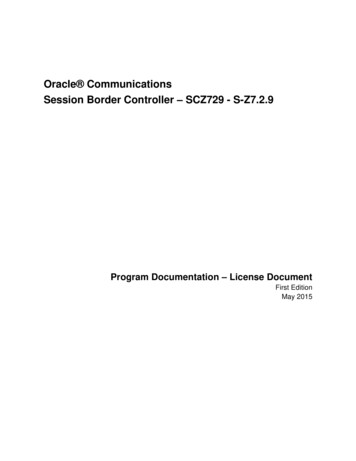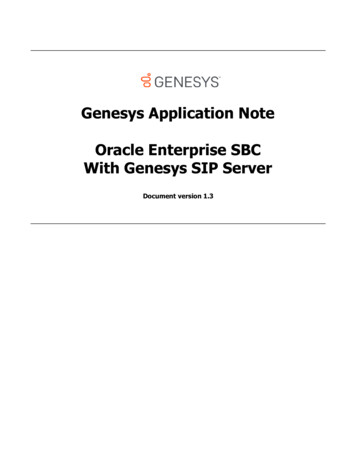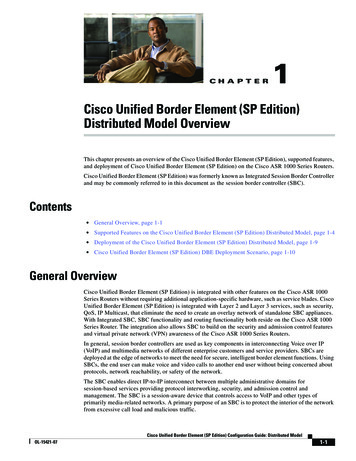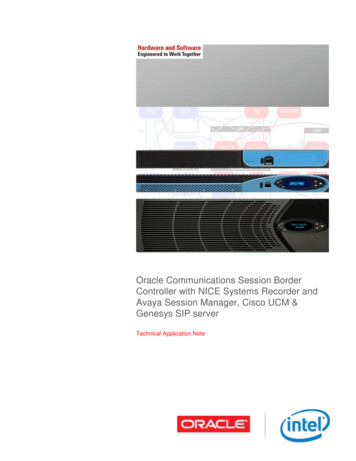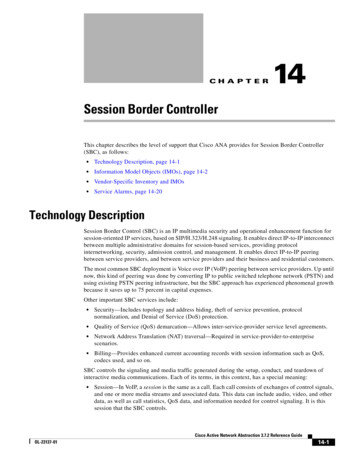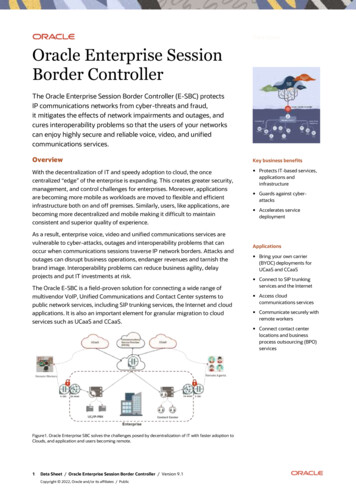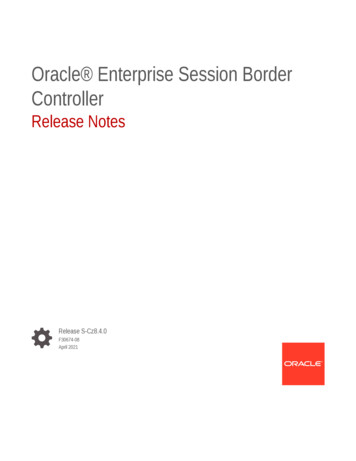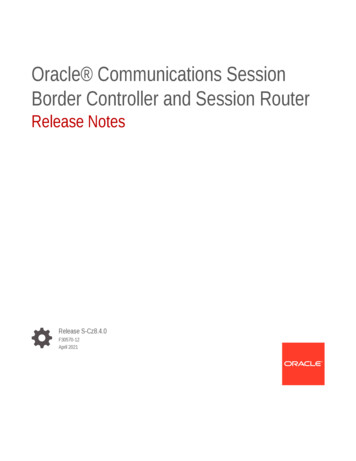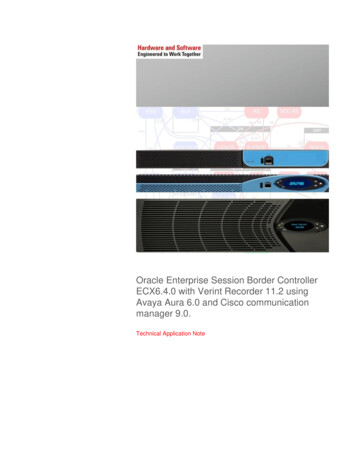
Transcription
Oracle Enterprise Session Border ControllerECX6.4.0 with Verint Recorder 11.2 usingAvaya Aura 6.0 and Cisco communicationmanager 9.0.Technical Application Note
DisclaimerThe following is intended to outline our general product direction. It is intended for information purposes only, and may not beincorporated into any contract. It is not a commitment to deliver any material, code, or functionality, and should not be reliedupon in making purchasing decisions. The development, release, and timing of any features or functionality described forOracle’s products remains at the sole discretion of Oracle.2
Table of ContentsINTENDED AUDIENCE.5DOCUMENT OVERVIEW .5INTRODUCTION .6AUDIENCE . 6REQUIREMENTS . 6ARCHITECTURE. 6CONFIGURING THE ORACLE ENTERPRISE SESSION BORDER CONTROLLER .8IN SCOPE . 8OUT OF SCOPE . 8WHAT WILL YOU NEED . 8CONFIGURING THE E-SBC . 9Establish the serial connection and logging in the E-SBC . 9Initial Configuration – Assigning the management Interface an IP address . 10Configuring the E-SBC . 11Verify configuration integrity . 39Save and activate your configuration . 39VERINT RECORDER CONFIGURATION CHANGES . 40STEP 1: DATA SOURCE LEVEL . 40STEP 2: MEMBER GROUP LEVEL . 41STEP 3: ASSIGN MEMBER GROUP PHONES . 42STEP 4: NETWORK CARDS LEVEL . 43STEP 5: INTEGRATION SERVICE SETTINGS . 44AVAYA CONTACT RECORDING SETUP . 46STEP1: INTEGRATION SERVICE SETTINGS . 46STEP 2: GENERAL SETUP FOR AVAYA 33XXXXATL. 46STEP 3: OPERATIONS LEVEL . 47AVAYA CM PBX CONFIGURATION ASPECTS. 48STEP 1: COMMANDS DISPLAY SETUP ON AVAYA PBX, NO SESSION-MANAGER USED FOR THIS LAB SETUP . 48STEP 2: SET UP SAME SIGNALING-GROUP 10 TO SUPPORT BOTH SIP TRUNKS 10 (INBOUND CALLS) AND 11(OUTBOUND CALLS) . 50CISCO UCM PBX CONFIGURATION ASPECTS . 55
STEP 1: SET UP 2 DEDICATED SIP TRUNKS ONE FOR EACH DEDICATED NETWORK-INTERFACE ON E-SBCCONFIGURATION SIDE . 55STEP 2: INBOUND CALLS THROUGH S0P0 . 55STEP 3: OUTBOUND CALLS THROUGH S0P1. 55STEP 4: ROUTE PATTERN . 56STEP 5: SIP PROFILE. 56STEP 6: SIP TRUNK SECURITY PROFILE . 57TEST PLAN EXECUTED . 59TROUBLESHOOTING TOOLS . 79WIRESHARK . 79ON THE E-SBC . 79Resetting the statistical counters, enabling logging and restarting the log files . 79Examining the log files. . 79APPENDIX A . 81ACCESSING THE ACLI . 81ACLI BASICS . 81CONFIGURATION ELEMENTS . 85CREATING AN ELEMENT. 85EDITING AN ELEMENT . 85DELETING AN ELEMENT. 86CONFIGURATION VERSIONS. 86SAVING THE CONFIGURATION . 87ACTIVATING THE CONFIGURATION . 88
Intended AudienceThis document is intended for use by Oracle Systems Engineers, third party Systems Integrators, and end users of the OracleEnterprise Session Border Controller (E-SBC). It assumes that the reader is familiar with basic operations of the Oracle EnterpriseSession Border Controller.Document OverviewThis document is intended for use as a guide for a successful integration of both Verint Recorder and Oracle Enterprise SessionBorder Controller. It outlines the architecture design, E-SBC configuration including troubleshooting tools, as well as test casesexecuted as part of the interoperability testing.
IntroductionAudienceThis is a technical document intended for telecommunications engineers with the purpose of configuring the Oracle EnterpriseSession Border Controller and the changes to be done in Verint Recorder, Avaya CM and CUCM for this interop testing.Understanding the basic concepts of TCP/UDP, IP/Routing, and SIP/RTP are also necessary to complete the configuration and fortroubleshooting, if necessary.Requirements Acme Packet 3800 with Firmware Release ECX6.4.0 MR-4 GA (Build 413) Avaya CM Software Version 6.02.0.823.0 Cisco UCM Software Version 9.0.1.10000-37 Avaya IP phone type 4625 Avaya One-X IP phone type 9620/9630 Cisco IP Communicator softphone Cisco IP phone type 7940 Verint recorder – Release 11.2ArchitectureThe following reference architecture shows a logical view of the connectivity between Avaya, Cisco and Verint elements and the ESBC.
Avaya CM 33xxxxCLAN IP10.156.7.187Service Provider ofEnterpriseCUCM 90xxx IP 10.199.1.8PSTN Service ProviderNW S1P0 IP10.156.7.53 6 33xxxxNWS0P1SIPREChome-realmNWS0P0 9 1907 90xxxOracle E-SBC 3820s/w version nnECX640m4The network diagram demonstrates that the E-SBC is connected as an edge component for the Avaya Session Manager and CiscoCall Manager. The E-SBC connects Enterprise to Enterprise via a SIP trunk, and the Verint recorder can be located on eitherdomain, but is located on a separate domain for this testing. The E-SBC supports the SIPREC standard which is used for recordingthe call and sending the recorded stream to the Verint recorders. The SIPREC protocol is used to interact between a SessionRecording Client (SRC - the role performed by E-SBC) and a Session Recording Server (SRS- Verint recorder).
Configuring the Oracle Enterprise Session Border Controller (E-SBC)In this section we describe the steps for configuring an E-SBC, formally known as the Acme Packet Net-Net Enterprise SessionDirector for use with Avaya CM, CUCM and Verint recorder in a SIP trunking scenario.In ScopeThe following step-by-step guide configuring the E-SBC assumes that this is a newly deployed device dedicated to a singlecustomer.Note that Oracle offers several models of SBCs. This document covers the setup for the Acme Packet 3820 and 4500 platformseries running ECX 6.4.0m4 or later. If instructions are needed for other Oracle E-SBC models, please contact your Oraclerepresentative.Out of Scope Configuration of Network management including SNMP and RADIUS; and Redundancy configuration Complete configuration of the Avaya Call Manager, Cisco UCM and the Verint recorder.What will you need Serial Console cross over cable with RJ-45 connector Terminal emulation application such as PuTTY or HyperTerm Passwords for the User and Superuser modes on the Oracle E-SBC IP address to be assigned to management interface (Wancom0) of the E-SBC - the Wancom0 management interfacemust be connected and configured to a management network separate from the service interfaces. Otherwise the E-SBCis subject to ARP overlap issues, loss of system access when the network is down, and compromising DDoS protection.Oracle does not support E-SBC configurations with management and media/service interfaces on the same subnet. IP address of the Avaya CM, CUCM and Verint Recorder IP address to be used for the E-SBC internal and external facing ports (Service Interfaces)
Configuring the E-SBCOnce the Oracle E-SBC is racked and the power cable connected, you are ready to set up physical network connectivity.Plug the slot 0 port 0 (s0p0) interface into your Avaya facing gateway and the slot 0 port 1 (s0p1) interface into Cisco facinggateway. The slot 1 port 0 (s1p0) is connected to the Verint recorder. Once connected, you are ready to power on and perform thefollowing steps.All commands are in bold, such as configure terminal; parameters in bold red such as ACMESYSTEM are parameters whichare specific to an individual deployment. Note: The ACLI is case sensitive.Establish the serial connection and logging in the E-SBCConfirm the E-SBC is powered off and connect one end of a straight-through Ethernet cable to the front console port (which isactive by default) on the E-SBC and the other end to console adapter that ships with the E-SBC, connect the console adapter (aDB-9 adapter) to the DB-9 port on a workstation, running a terminal emulator application such as PuTTY. Start the terminalemulation application using the following settings: Baud Rate 115200 Data Bits 8 Parity None Stop Bits 1 Flow Control NonePower on the E-SBC and confirm that you see the following output from the bootup sequence.
Enter the following commands to login to the E-SBC and move to the configuration mode. Note that the default E-SBC password is“acme” and the default super user password is “packet”.Password: acmeACMESYSTEM enablePassword: packetACMESYSTEM# configure terminalACMESYSTEM(configure)#You are now in the global configuration mode.Initial Configuration – Assigning the management Interface an IP addressTo assign an IP address, one has to configure the bootparams on the E-SBC by going toACMESYSTEM# configure terminal --- bootparams Once you type “bootparam” you have to use “carriage return” key to navigate down A reboot is required if changes are made to the existing bootparams
ACMESYSTEM#(configure)bootparam'.' clear field; '-' go to previous field; q quitboot device: eth0processor number: 0host name: acmesystemfile name: /code/images/nnECX640m2.tar--- location wherethe software is loaded on the SBCinet on ethernet (e): 172.18.255.52:ffffff80 --- This is the ipaddress of the management interface of the SBC, type the IP address andmask in hexinet on backplane (b):host inet (h):gateway inet (g): 172.18.0.1 --- gateway address hereuser (u): vxftpftp password (pw) (blank use rsh): vxftpflags (f):target name (tn): ACMESYSTEMstartup script (s):other (o):Configuring the E-SBCThe following section walks you through configuring the Oracle Enterprise Session Border Controller to work with the Avaya CM,Cisco CM and the Verint recorders.The calls are recorded by a Verint recorder which is added to the configuration using session-recording-server and sessionrecording-group. The session recorders are defined in the session-recording-group, and the session-recording-group is referencedfrom the realm-config. In our case, the session-recording-group has three session recording servers SRS1, SRS2 and SRS3 whichare defined in the group using Hunt strategy. Also, since we need all the calls to be simultaneously recorded, simultaneousrecording-servers is defined as 3. The session-recording-server element has details of the session recorder such as the IP and port,as also the realm to which it belongs. Another field with reference to call recording in the realm-config is the session-recordingrequired. If session-recording-required enabled, then the calls between the two parties will not go through unless the sessionrecorder is ready and available to record.Also, as often in contact center applications, a unique ID is needed to co-relate the recorded calls, an Avaya UCID is used for thispurpose in this testing. The Universal Call Identifier SPL plug-in generates or preserves a UCID based on configuration. Once aUCID is generated or preserved, the system adds the value to all subsequent egress SIP requests within the session. This SPLplugin is already present in /modules in the ECX640m4 image, so it need not be explicitly loaded on the E-SBC, but you do need toenable the plugin with the SPL option UCID-App-ID 0024 in the spl-config element. The UCID-App-ID SPL option allows the ESBC to examine ingress SIP requests for the “User-to-User” header. When present, the header is transparently passed through theegress SIP message. If set to replace-ucid or the header is not present, the system generates a new value for “User-to-User”.
You must set the value to a 2-byte hex-ascii value that represents the app ID which is the identifying value, as defined by thevendors. All input is truncated to 4 characters. Any characters outside the range of 0-9 and A-F will result in an invalid User-to-Userheader. The UCID is added as an extension data to the session element of the recording’s metadata when using SIPREC.It is outside the scope of this document to include all the interoperability working information as it will differ in every deployment.Following is the configuration with which the testing has taken n@console2014-02-02 12:30:02**ACM33xxxxATL realmlocal policy Avaya33xxxxenablednone10.199.1.8CUCM90xxxATL led
-ports-per-flowadmin@10.61.20.682014-03-23 05:44:00*33CUCM90xxxATL realmlocal policy Cisco90xxxenablednone10.156.7.187ACM33xxxxATL ledadmin@10.61.20.682014-05-04 07:42:06enabledenabled86400300300864003003002
isableddisableddisabledadmin@console2013-12-17 12:03:00S0P00Avaya Traffic10.156.9.1255.255.0.010.156.0.254
.6010.156.7.61admin@10.56.20.142014-07-29 15:18:02S0P10Cisco 10
156.7.51admin@console2014-02-02 11:38:32S1P00recorder network 110.156.7.5310.156.7.53admin@console
alth-scoreoverload-protection2014-02-02 admin@10.61.20.682014-03-23 admin@console2013-12-18 11:04:45S1P0Media01enabledenabledFULL10050disabled
cy-svradmin@console2014-02-02 11:25:36ACM33xxxxATL CME NAT TO FROM IP0none00003000
eddisablednonedisableddisabledSRG:SBC TLV SRGdisableddisabled0.0.0.034780.0.0.03479
ableddisabledadmin@10.61.20.682014-05-12 08:28:23CUCM90xxxATL ACME NAT TO FROM IP0none0000
leddisabled0.0.0.034780.0.0.0
e2014-02-02 12:21:32Recorder realmVerint disableddisableddisabled0000000disabled0none
disableddisablednonedisableddisableddisabled
0.682014-05-12 icTCPACM33xxxxATL realmAvaya33xxxxATL c-lan08a13enableddisabled0000000005000
NS30keep-alivedisabledhuntUCID-App-ID 0024disabled0disablednone0disabled
colapp-typetransport-meth
The following section walks you through configuring the Oracle Enterprise Session Border Controller to work with the Avaya CM, Cisco CM and the Verint recorders. The calls are recorded by a Verint recorder which is added to the configuration using session-recording-server and session-recording-group. The session recorders are defined in the .
